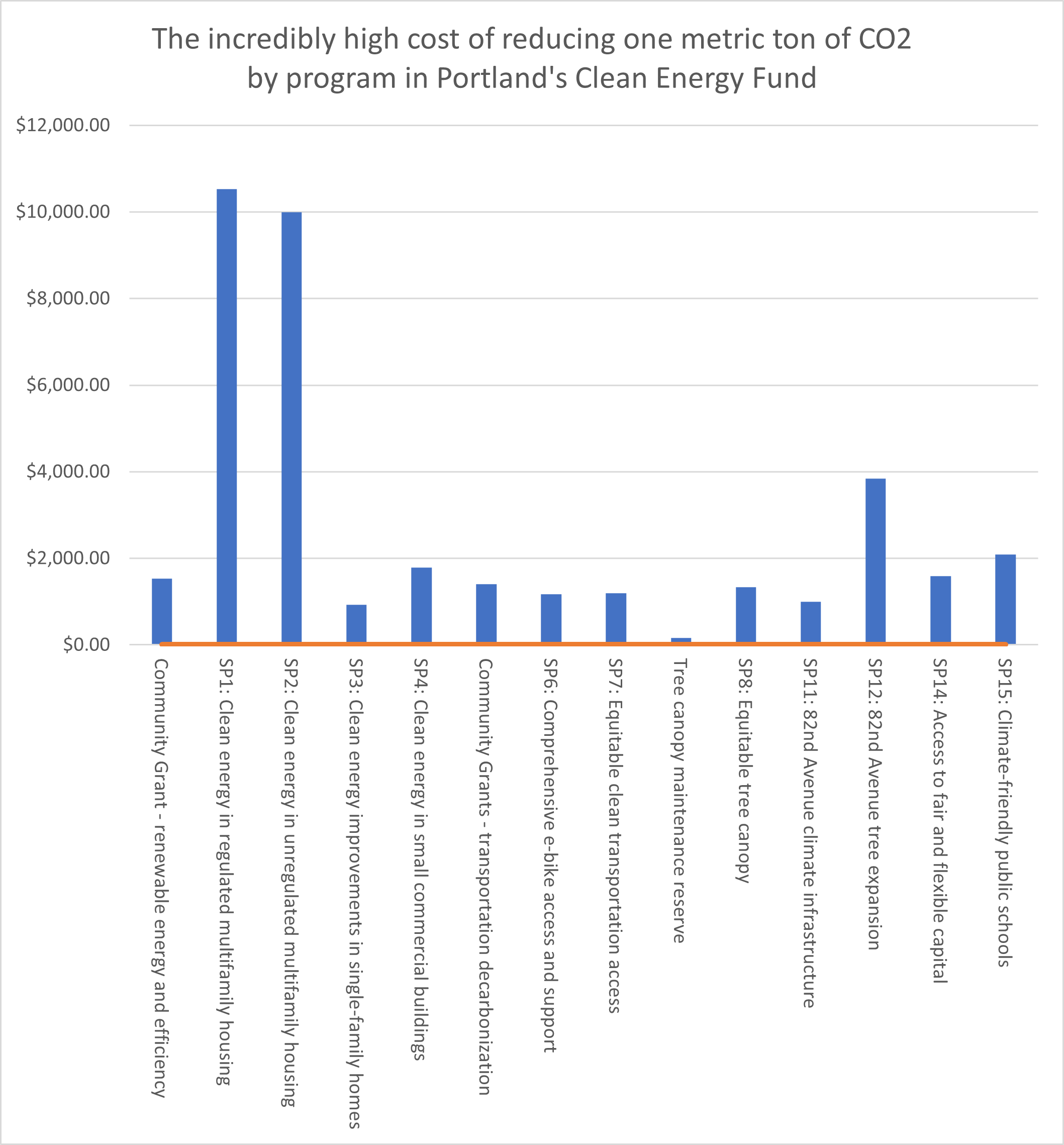Are government climate expenditures designed to reduce greenhouse gas emissions or are they excuses to send taxpayer money to politically connected communities? Based on the proposed spending in Portland’s Clean Energy Fund, the answer is clearly the latter.
The Portland City Council is considering how to spend $750 million in a new round of grants part of the city’s Clean Energy Fund (PCEF). Adopted by city voters in 2018, the ballot asked voters to approve a tax that would “fund clean renewable energy (defined) projects, [and] job training.” The Portland City Council is now considering how to spend $750 million more on the “Climate Investment Plan” with the goal of “cutting emissions, increasing shared prosperity.”
And while the city calls it “a historic program that centers equity in climate action,” there is virtually no “climate action” in the program. It spends hundreds of millions of dollars for CO2 reductions that could be achieved for less than one percent of that amount.
It might be the worst climate policy in the nation.
The draft plan released earlier this year lists two dozen areas where the $750 million in grants will be allocated. The categories include “Clean energy in regulated multifamily affordable housing,” “Equitable tree canopy,” “Increasing urban farming opportunities – planning and land acquisition,” and “Comprehensive e-bike access and support.” In each category, the plan lists the amount to be allocated as well as projecting the expected “lifetime CO2e emissions reduced.” By calculating the amount of CO2e – CO2 emissions equivalent which includes other greenhouse gases like methane – per dollar, we can assess the effectiveness of the program compared to alternatives.
The best comparison standard is the cost of private carbon-reduction projects offered by the Bonneville Environmental Foundation, located in Portland. They offer investments in projects that cost about $14 per metric ton (MT) of CO2e for projects that capture HFCs, which are very powerful greenhouse gases. Comparing the effectiveness of the projects in the PCEF to these projects helps gauge the relative effectiveness for the planet.
The result isn’t good for the Portland’s program, with some categories spending more than 1,000 times as much as widely available CO2-reduction projects.
 For example, the program provides $60 million for “Clean energy in regulated multifamily affordable housing.” Writing, “It is imperative that these buildings are built and operated in a way that reduces carbon emissions, reduces operating costs, and improves resilience and health for tenants,” the description does not explain how carbon reduction will be achieved. Instead, it promises the city will work with “community partners to define Phase II program parameters to see greater carbon reduction, benefit to tenants, and additional or different workforce contractor equity requirements.”
For example, the program provides $60 million for “Clean energy in regulated multifamily affordable housing.” Writing, “It is imperative that these buildings are built and operated in a way that reduces carbon emissions, reduces operating costs, and improves resilience and health for tenants,” the description does not explain how carbon reduction will be achieved. Instead, it promises the city will work with “community partners to define Phase II program parameters to see greater carbon reduction, benefit to tenants, and additional or different workforce contractor equity requirements.”
The city estimates this will result in “An estimated range of 3,400 - 5,700 MT lifetime CO2e emissions,” putting the cost per metric ton of CO2 at between $10,526 and $17,647. That is crazy. I can’t remember ever seeing a cost that high. It is particularly remarkable when, in the same city, the Bonneville Environmental Foundation offers projects that achieve the same environmental benefit for $14 per MT.
If the Portland City Council simply spent that money to invest in CO2-reduction projects widely available from BEF or others, they could receive up to 1,261 times as much climate benefit. When the city can get the same environmental benefit for 0.06 percent of the cost, it is clear the program isn’t designed around “climate action.”
Other categories aren’t as bad but are still extremely ineffective. There is $25 million for “Equitable clean transportation access.” The funding would offer “qualifying participants a package of free transportation options such as public transit passes, bike share (BIKETOWN), e-scooter ride credit, and ride-hailing (Uber/Lyft) or taxi credit.”
Over the course of five years, the city projects the program will result in 15,000 – 21,000 MT CO2e reduced over the five-year program. That puts the cost of the program at between $1,190 and $1,667 per MT CO2. While not as extravagant as the previous program, it is still 119 times as expensive as the alternatives.
Of the 14 grant programs covering $617 million designed to reduce CO2 emissions (using the highest projection in each category), the average cost to reduce one MT of CO2e is $1,438.23.
That price is simply not defensible for a program that calls itself a “climate investment plan.”
I did leave one category out of that calculation: the “Targeted Electric Financing Tools.” The simple reason is that their CO2e reduction projection is unreliable.
The plan allocates $35 million to offer “reduced origination fees or interest rates, credit enhancement mechanisms, matched savings programs, or lending pathways with flexible terms will provide access to electric vehicles for PCEF priority populations.” It doesn’t explain what that amounts to in practical terms but projects a reduction of 1.2 million MT of CO2 over the lifetime of the program. The plan says, “Emissions savings estimated based on the expected number of electric vehicles replacing gas-powered Class 2 and 3 commercial vehicles,” which are the equivalent of a Ford F-150 up to a F-450.
The projection seems to assume that without the program no vehicles would be purchased, which is generous.
There is another problem: there are currently no electric Class 3 vehicles. Additionally, there are very few Class 2 electric vehicles and they are expensive. The Ford F-150 Lightning retails for about $50,000, while the gas-powered version starts at about $34,000. That’s a big gap to be made up.
Using the EPA’s Fuel Economy Guide, the average F-150 emits about 85 MT of CO2 over a 10-year lifespan. To avoid 1.2 million MT of CO2, the program would have to be responsible for the purchase of 14,384 new F-150s, which amounts to a subsidy of $2,433 per truck. That leaves $13,566 of the gap to be made up. It is possible that the $2,433 subsidy could be the difference between someone choosing an electric truck over a standard gas or diesel truck, but it seems optimistic, especially when some of the vehicles included in the project don’t exist.
Even if I am wrong, the average cost of reducing one MT of CO2e in the Clean Energy Fund is still $395, which is nearly 40 times as much as the most cost-effective alternatives.
There simply isn't a way to justify these expenditures as a climate policy. The Clean Energy Fund is really a social program for politically targeted communities rather than a climate program.
For that reason, the likely response will be that this program is about more than just reducing CO2 emissions. The plan itself says the program “considers benefits to frontline communities, implementation feasibility, greenhouse gas (GHG) emissions reductions, and accountability.” It is certainly fine to argue there are benefits beyond greenhouse gas emissions reductions. But there are a couple of problems with that.
First, the program is called the “Clean Energy Fund,” and the strategy is the “Climate Investment Plan.” The estimated GHG reductions are so tiny for the cost, claiming it as a goal of the program doesn’t make sense. The CO2e reductions could be achieved for less than 1 percent of the total cost of the program. The spending doesn’t match the publicly stated purpose.
Second, there are few metrics of success listed in the plan for the non-climate goals, or the metrics are vague. For example, the funding for “Clean energy improvements in single-family homes,” lists “Homes will have improved comfort, safety, and climate resiliency” as an outcome. They don’t offer a way to measure those outcomes.
The “Equitable clean transportation access” category pledges to provide “15,000 – 20,000 priority population members with increased access to clean transportation options.” Does “increased access” mean people use them or just that they may use them?
If the people of Portland believe spending taxpayer dollars on these projects is worthwhile, that is their choice, but given the large amount of money, there seems to be little certainty that the program will achieve the intended goals.
There is a remarkable gap between the political rhetoric around climate change, claiming it is an existential crisis, and the actions of politicians who make virtually no effort to ensure the money they spend to address the problem is actually effective in solving that crisis. Politicians rarely ask for evidence that programs are effective and that money is spent wisely. Portland’s city council members are not alone in their failure to ask if the three-quarters of a billion dollars in the PCEF is being spent wisely. That failure, however, is a clear acknowledgment that the council is focused more on its rhetoric than the results.





